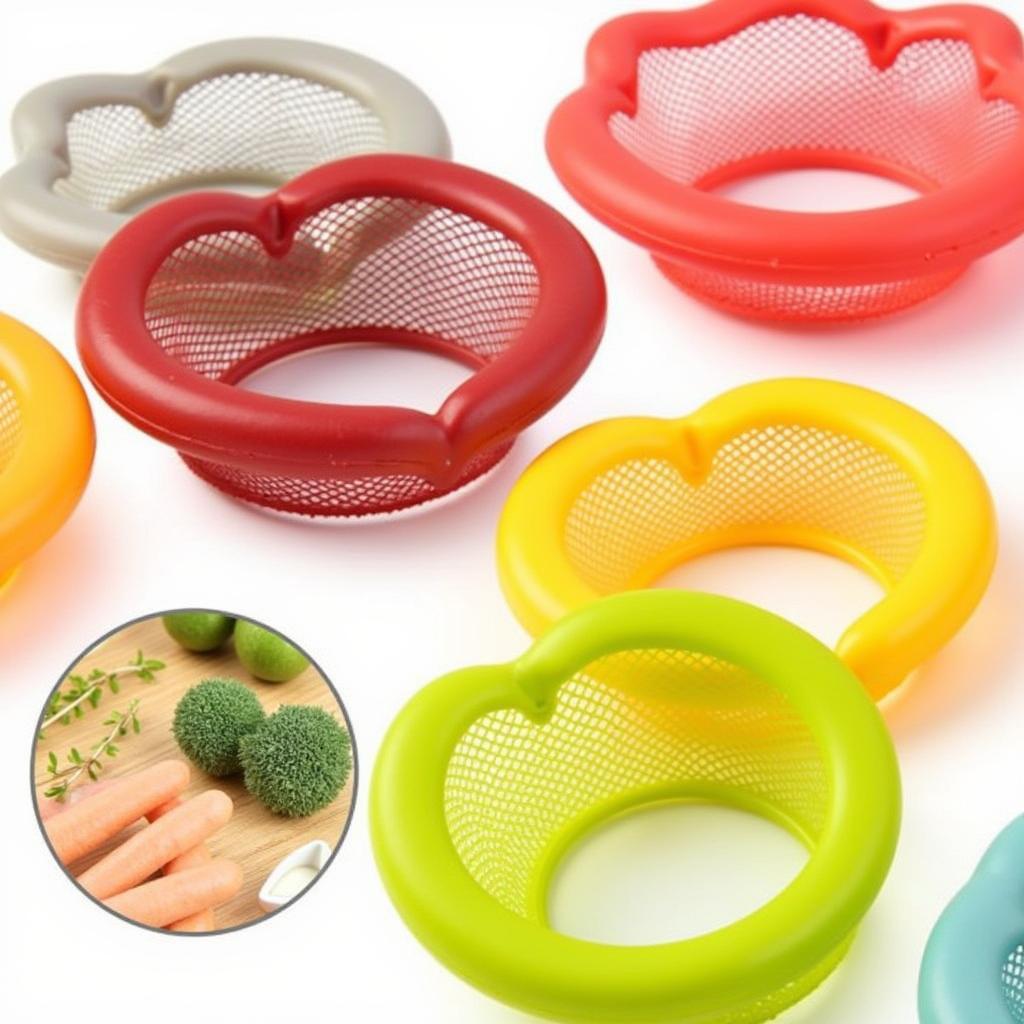Teether With Food offers a natural and often delicious way to soothe your baby’s teething discomfort. This comprehensive guide explores the benefits, safety precautions, and best food options for using a teether with food. We’ll also address common concerns and provide practical tips to make this teething experience enjoyable for both you and your little one.
Understanding the Need for a Teether with Food
Teething can be a challenging time for babies and parents alike. The pressure and inflammation in the gums can cause irritability, excessive drooling, and difficulty sleeping. Teethers provide counter-pressure, which can help alleviate some of these symptoms. Adding food to the teether adds another layer of relief by providing a cooling sensation and a flavorful distraction. What’s more, a teether with food can be a great introductory step to solid foods, allowing babies to explore different textures and tastes in a safe and controlled manner.
Choosing the Right Teether with Food
Not all teethers are designed to hold food. Look for teethers specifically made for this purpose, often with mesh or silicone compartments that allow your baby to safely gnaw on the food without the risk of choking. Opt for food safe popsicle sticks to create homemade frozen treats. Make sure the teether is BPA-free, phthalate-free, and easy to clean. The size and shape should be appropriate for your baby’s age and developmental stage.
Safe and Delicious Food Options for Teething
When choosing foods for your baby’s teether, prioritize options that are nutritious, soft, and easy to mash or puree. Frozen fruits like bananas, strawberries, and peaches are excellent choices, providing a cooling sensation and essential vitamins. You can also try chilled pureed vegetables like carrots or sweet potatoes. Remember to avoid allergens and consult with your pediatrician before introducing new foods, especially if your baby has any food sensitivities. Consider our strawberry banana baby food recipe for a tasty and nutritious option.
 Various frozen fruit and vegetable puree filled teethers
Various frozen fruit and vegetable puree filled teethers
What to avoid when using a teether with food?
Avoid hard foods that could pose a choking hazard, such as raw carrots or apples. Also, steer clear of sugary foods or juices, as they can contribute to tooth decay. Honey should never be given to infants under one year old due to the risk of botulism. Always supervise your baby while they are using a teether with food and ensure the teether is clean and in good condition.
Cleaning and Sterilizing Your Teether
Proper hygiene is essential to prevent bacteria growth. Wash the teether thoroughly with soap and water after each use. You can also sterilize the teether using a food sterilizer. Ensure all parts are completely dry before storing.
Expert Insight: Dr. Emily Carter, Pediatric Dentist
“Teethers with food can be a wonderful tool for soothing teething pain, but safety is paramount. Choose appropriately sized and shaped teethers and always supervise your baby during use.”
Conclusion
A teether with food can be a safe and effective way to alleviate your baby’s teething discomfort. By following these guidelines and choosing the right foods, you can make this challenging phase a little easier for both you and your little one. Remember to prioritize safety, hygiene, and nutritional value when selecting foods and teethers. Teether with food provides a comforting and enjoyable teething experience.
FAQ
- At what age can I introduce a teether with food? Around 4-6 months, when teething typically begins.
- Can I freeze breast milk in a teether? Yes, it’s a safe and soothing option.
- How often should I clean the teether? After every use.
- What if my baby doesn’t like the teether with food? Try different food options or teether styles.
- Can I leave my baby unattended with a teether with food? No, always supervise your baby.
- What are signs of teething? Increased drooling, irritability, and chewing on objects.
- Can I put medication in the teether? No, consult your pediatrician for pain relief options.
Common Teething Scenarios and Questions
- Baby is constantly fussy and drooling: This is a common sign of teething. Offer a chilled teether with food for relief.
- Baby is refusing to eat: Teething pain can make eating uncomfortable. Try softer foods and a chilled teether.
- Baby is waking up more at night: Teething pain can disrupt sleep. Offer a teether before bedtime and during night wakings.
Further Resources
For more information on baby food and teething, visit our website’s other resources on baby food teether and food sterilizer.
Need Help? Contact Us!
For further assistance, please contact us: Phone: 02437655121, Email: minacones@gmail.com. Visit us at: 3PGH+8R9, ĐT70A, thôn Trung, Bắc Từ Liêm, Hà Nội, Việt Nam. We have a 24/7 customer support team.